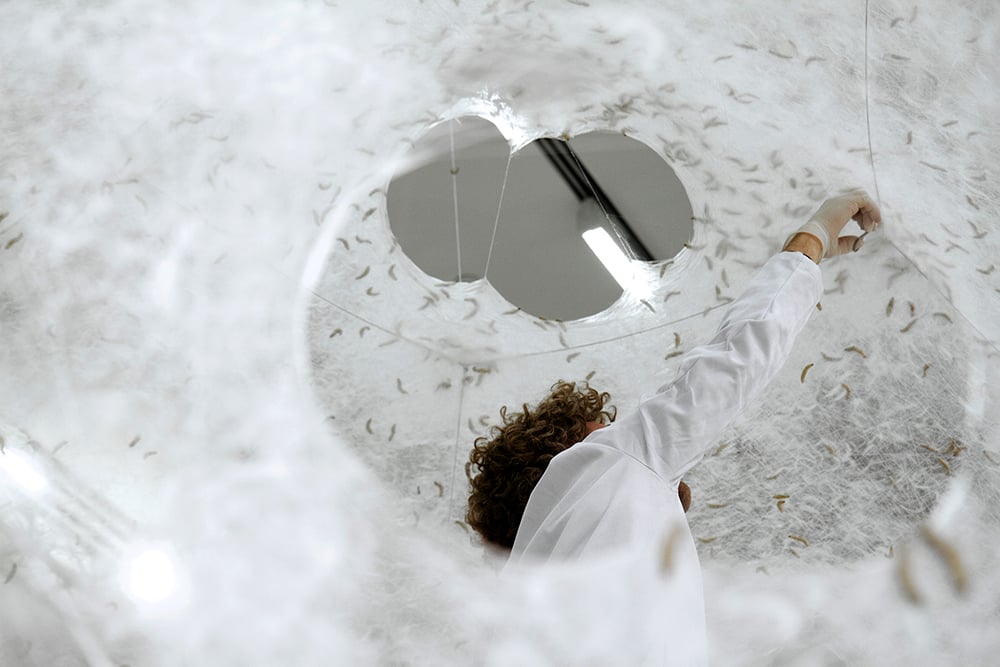
December 2, 2013
Critics and Thinkers Pick the Most Significant Design Developments of 2013
What are the most important buildings, products, or events of 2013 that have ramifications for the future?
We asked 20 critics and thinkers from around the world to identify the most significant developments from this year. Their intriguing responses illuminate some of the ideas now driving architecture and design.
New Ways of Making

Neri Oxman and her team at MIT (above) deployed 6,500 silkworms to weave a cocoon over a network of digitally placed threads to create the Silk Pavilion (below).
Courtesy Steven Keating
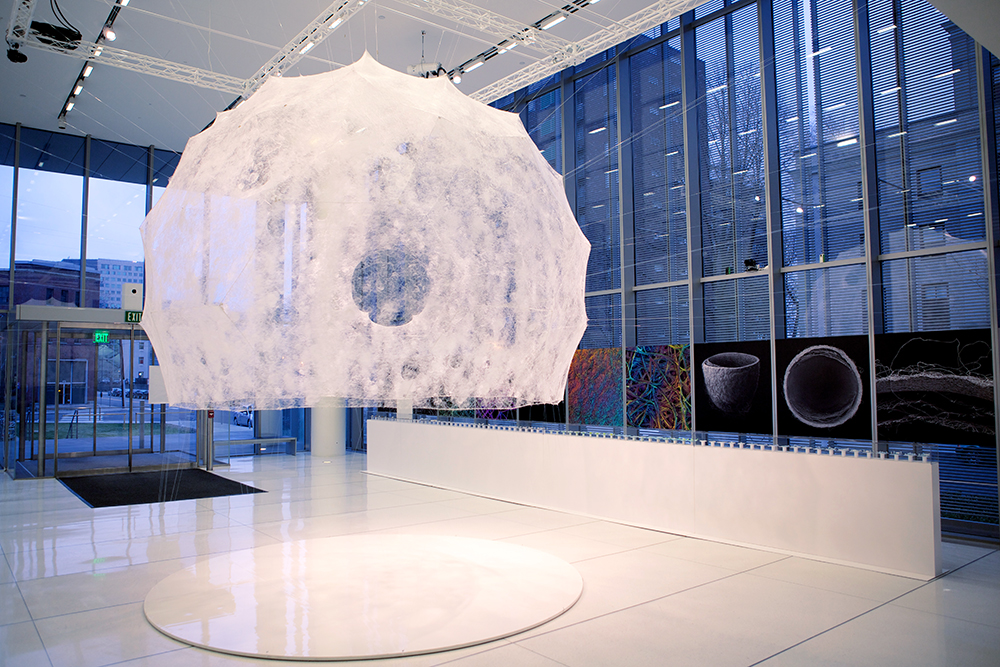
GLENN ADAMSON: BIO-CRAFT
Neri Oxman explores how traditional ways of making can be reinvented for the twenty-first century. This project utilizes an amazing, intuitive combination of an old technology—silkworm cultivation and the creation of textiles through these little creatures—and CNC-controlled fabrication technology. So, it’s not a matter of displacing old techniques; it’s about adding another layer on top of them, like a geological stratum.
Adamson is the Nanette L. Laitman Director of the Museum of Arts & Design.

Illustration by Lief Parsons
STEVE HELLER: THE MAKERS RULE
Entrepreneurship is endemic to designers. They make things, and there are many things, from books to apps, from the quirkiest to the most mainstream, being created by designers who now see ways of marketing them directly to an audience through the Web. Unit Editions in London is on the top of this list. They’re working in books, but with a totally new, designer-driven business plan. And let’s not forget Etsy, making it so easy to make, test, and profit. Designers need more revenue streams. Businesspeople may have a good idea for a product; the designer with the same idea simply will make it happen. The distribution networks have changed as radically as they did a century ago with the establishment of interstate roads and railways. Design entrepreneurship is not new, but it’s more accessible because of technology and the new business models it enables.
Heller is the co-chair of the SVA MFA Design: Design as Author & Entrepreneur program.
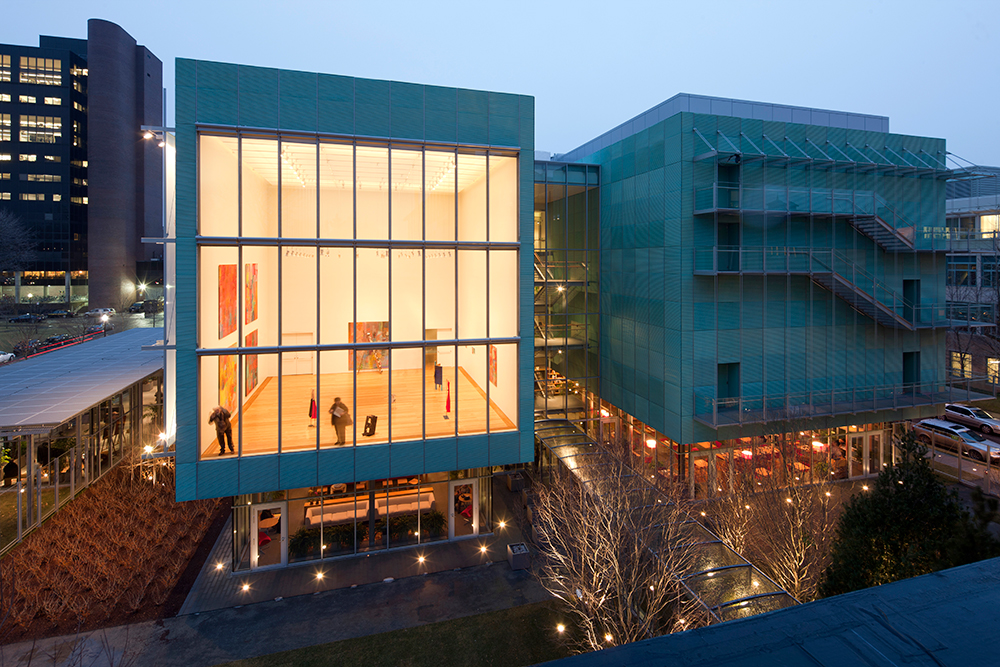
The Renzo Piano Building Workshop recently completed a 70,000-square-foot addition to the Isabella Stewart Gardner Museum in Boston.
Courtesy Nic Lehoux
ROBERT CAMPBELL: HIGH-TECH NOSTALGIA
I was a member of the building committee for the Renzo Piano addition to the Isabella Stewart Gardner Museum, and the experience got me thinking about a phenomenon I’d call RetroTech: It’s the passionate love affair with the visual and physical intricacy of the products of the Industrial Revolution, as compared to the sleek products of the current digital age. A good example: the watch ads in the New York Times Magazine, each of which looks like a tiny glass museum of the bolts and gears and other gadgetry of a world that is disappearing. Just as Arts & Crafts rebelled against the Industrial Revolution and recalled an earlier time, RetroTech now rebels against the digital age and harks back to the gritty Industrial Revolution.
Campbell is the architecture critic at the Boston Globe.
Activism and Design
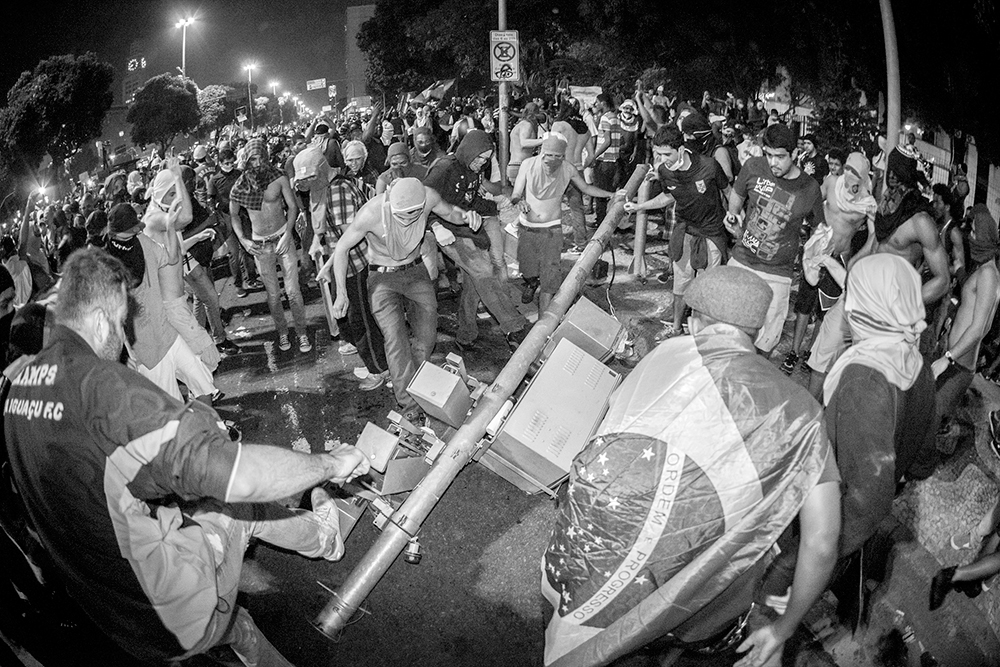
While billions of dollars were being spent on sporting events, the city of Rio announced a hike in public transit fares in June, sparking widespread protests.
Courtesy Alex Carvalho
JUSTIN McGUIRK: HOLD AN EQUITABLE OLYMPICS
This summer’s protests in Rio spoke volumes about the way cities are made. A million people took to the streets to protest against poor public services. Many find it galling that billions are being spent on World Cup and Olympic sites when public services are in a parlous state. The protests asked: Who is the city for? Is it for FIFA and the International Olympic Committee? Rio, with its 1,000 favelas, ought to be an exemplar of how sporting mega events can benefit the host city, but the opportunity is passing.
McGuirk is a London-based writer, critic, and curator.

Christoph Gielen’s Untitled XV Arizona is part of his “American Prison Perspectives” series.
MARK LAMSTER: END THE PRISON-INDUSTRIAL COMPLEX
The U.S. has an entire shadow population in prison. How we treat that population is one of the great questions before us. Raphael Sperry and Architects/Designers/Planners for Social Responsibility are doing incredibly important work on the ethical implications of building solitary confinement cells and prisons. America has to address this issue. We have privatized prison construction, and the results of that business model have been destructive to both families and our culture. We need to rethink our obsession with putting more people in prison, because it doesn’t work and it’s morally indefensible.
Lamster is the architecture critic at the Dallas Morning News.

The Zimba automatic chlorine dispenser is capable of delivering clean water to both urban and rural populations. It mixes chlorine into drinking water at the safe, required levels.
Courtesy Zimba and Laura Stupin
CAROLINE BAUMANN: THE PERSISTENT CHALLENGE
Water purification really equates to medicine in large parts of the world. Delivering clean water to communities is a serious design challenge. While there are many solutions, I admire Zimba’s automatic chlorine dispenser, designed by Suprio Das. The device delivers clean water by precisely mixing chlorine at the required levels. The scale, safety, simplicity, and low cost of this initiative is impressive.
Baumann is the director of the Cooper-Hewitt, National Design Museum.
Technology Troubles
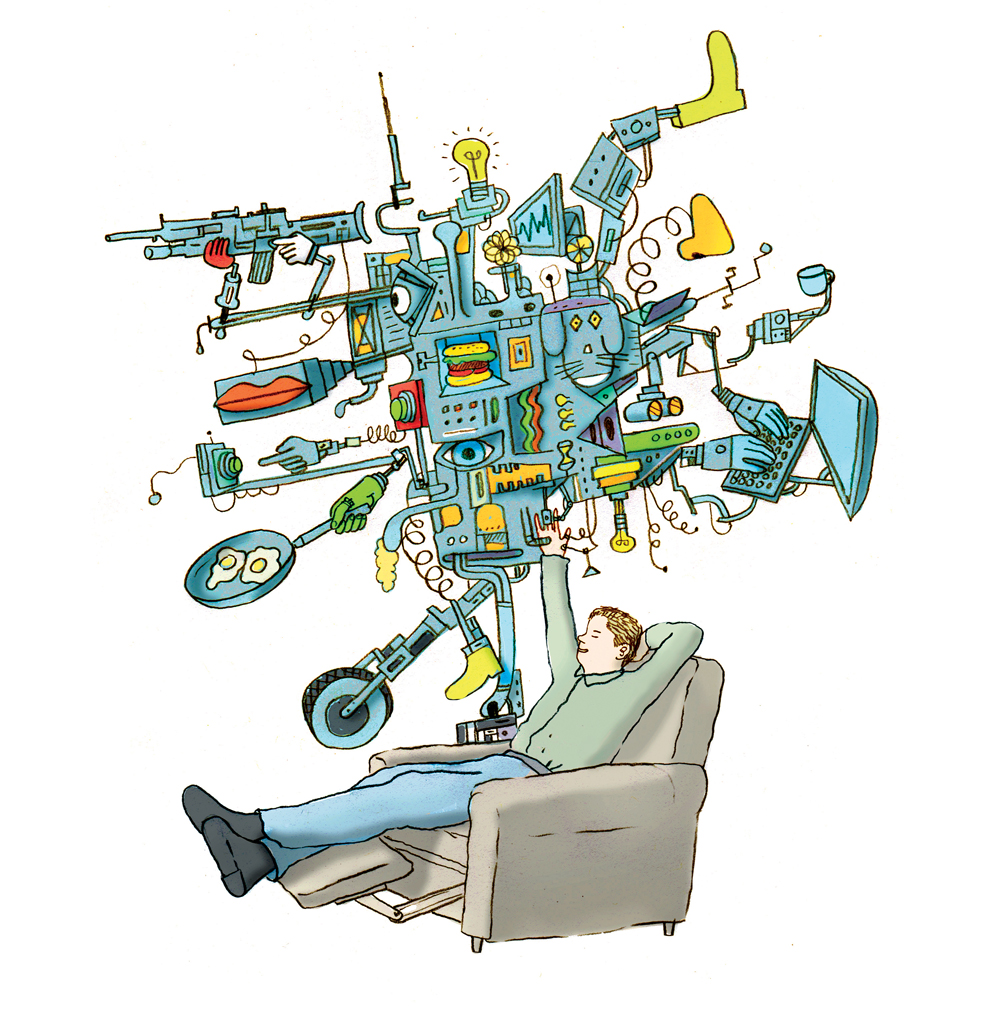
Illustration by Lief Parsons
DONALD NORMAN : THE ROBOTS ARE AFTER YOUR JOB
The most important event this year was the continuing rise of intelligent machines: Everything from automobiles and cooking robots to medical diagnoses and fully automated, autonomous drones. White-collar jobs are now easier to automate than manual labor. The ramifications are immense.
Norman is the author of Things That Make Us Smart: Defending Human Attributes in the Age of Machines.
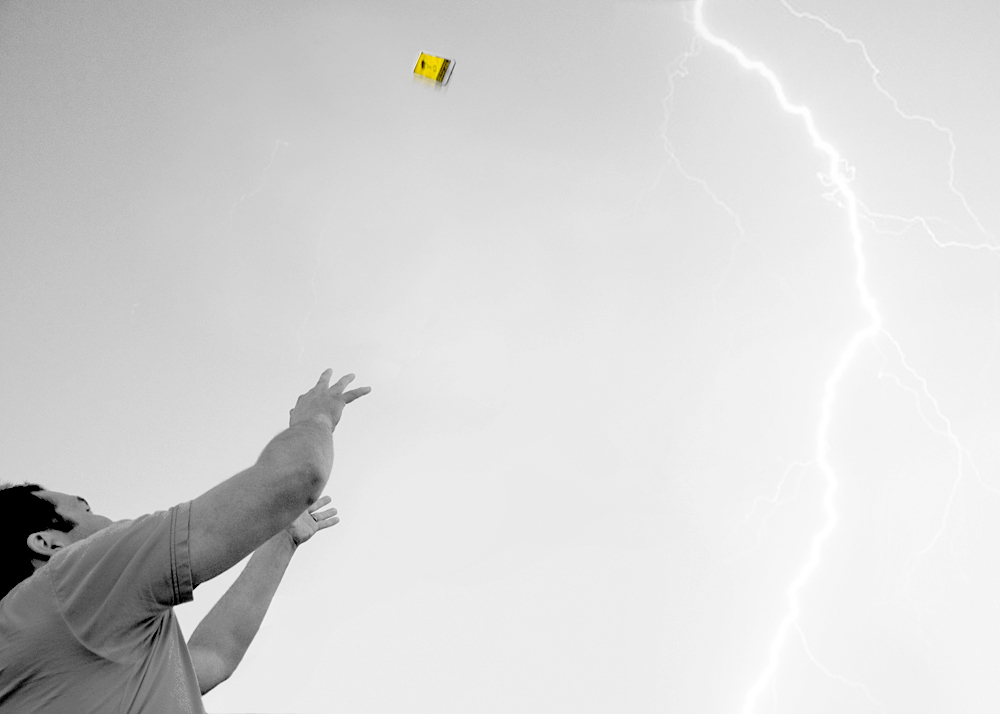
The Send Me to Heaven app, developed by Carrot Pop, measures how high your phone travels when it’s tossed in the air. Apple banned it.
Courtesy Carrot Pop
ALLAN CHOCHINOV: THE APP THAT KILLS YOUR PHONE
There’s an onslaught of apps coming at us every day—some amazing and useful like those for medical diagnostics, and others pretty frivolous. But the Send Me to Heaven app might mark something significant, representing an end point, or a kind of “last app,” in the way that “The The” might be viewed as the “last band name.” Indeed, if you fail to catch your phone on the way down, this literally will be your last app. But, as a cultural moment, this app asks: What’s the point of a mobile device? What are the limits of games? And, finally, what’s the tension between entertainment and waste? On first look, it seems ridiculous, but maybe it isn’t so ridiculous. Maybe it actually asks us something important.
Chochinov is a partner at Core77 and chair of the new MFA Product of Design program at the School of Visual Arts.
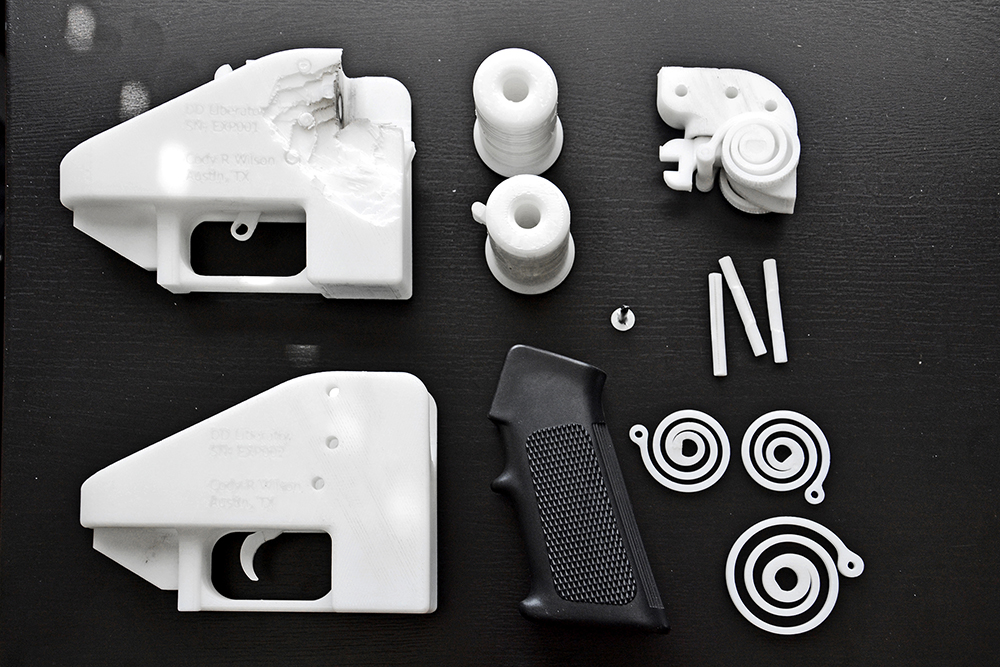
Critics insisted that Defense Distributed’s 3-D printed gun was impractical, until it was finally used to fire a shot. The gun was recently acquired by London’s Victoria and Albert Museum.
Courtesy Defense Distributed
ALICE RAWSTHORN: THE DARK SIDE OF DIY
Sometimes design polemics can be as, if not more, important as design projects. An example is the controversy caused by the Liberator, the 3-D printed gun whose design template was posted online by the Texas-based organization Defense Distributed. Up until then, the design community had adopted an optimistic stance on digital production technologies like 3-D printing, understandably so. Not only do they offer significant environmental benefits, these technologies promise to transform the relationship between designers and the people who use their work, while reviving the tradition of repairing and defining a new design aesthetic. Not bad. But the Liberator illustrated the peril of failing to consider the negative consequences of such powerful technologies. By demonstrating the danger of failing to design their development intelligently, it made an incontestable case for the importance of thoughtful and sensitive design.
Rawsthorn is the author of Hello World: Where Design Meets Life.
PAUL GOLDBERGER: BURNING ISSUE
In a weird way, I think that Rafael Vinoly’s Walkie-Talkie building in London is the most significant project this year, because it refocused the discussion about big-name architects and all the now somewhat tiresome issues of arbitrary form-making, and brought it around to create a heretofore unseen but urgent connection with issues of the environment and sustainability. It’s an important issue to discuss, not only because the Vinoly building is so awful, but also because its sins will probably be misinterpreted by many as a sign that there is risk in new form.
Goldberger is a contributing editor at Vanity Fair.
The Art of Reuse
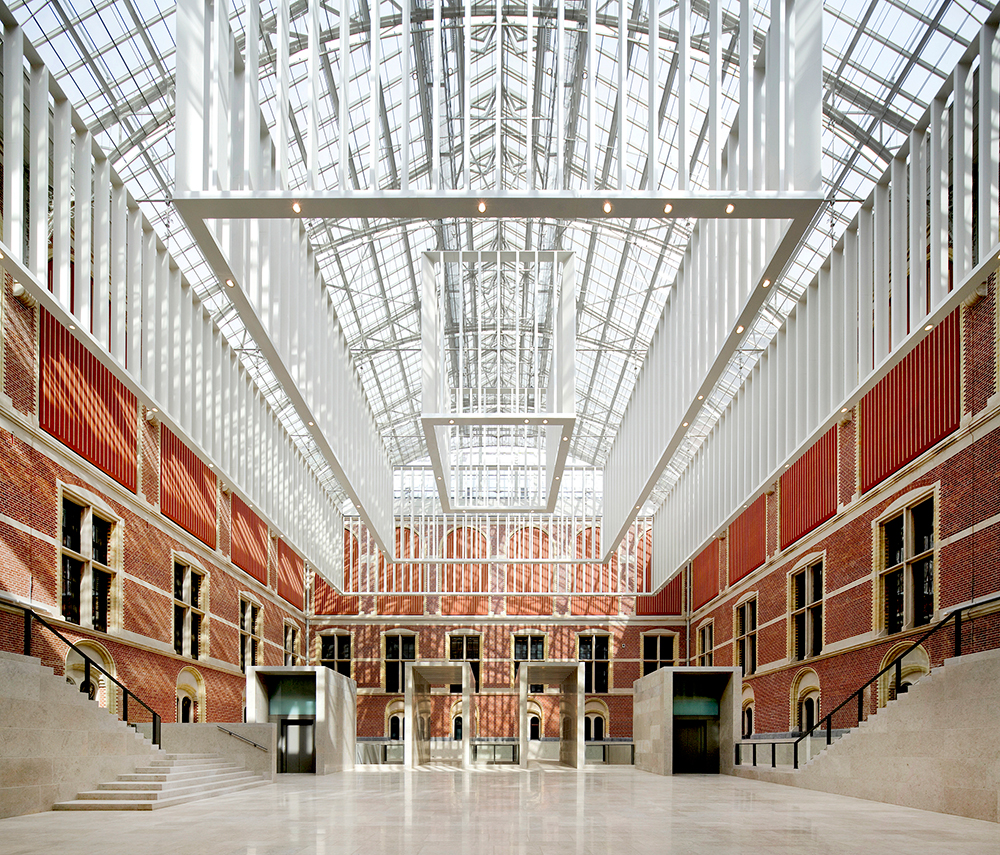
The 1885 Rijksmuseum in Amsterdam, designed by Pierre Cuypers, was recently renovated by Spanish architects Antonio Cruz and Antonio Ortiz.
Courtesy Pedro Pegenaute
AARON BETSKY: RENOVATE AND REVISE
Why the Rijksmuseum? First of all, it’s magnificent. Second, it’s one of the most important art museums in the world that had been closed to the public for ten years to do this renovation. And third, it signals what I think is the increased importance of renovating and reusing. We need to learn how to make do with what we have, but also on a philosophical level the ideas that we need to always be looking for the new, the un-thought-of, and must impose alien forms and alien ideas on the world should give way to a way of thinking about design as a gathering of what is already there, reorganizing and reassembling it, and thinking about it in a different way so that we see our work as designers more as that of hunters and gatherers and less of as genius inventors.
Betsky is the director of the Cincinnati Art Museum.
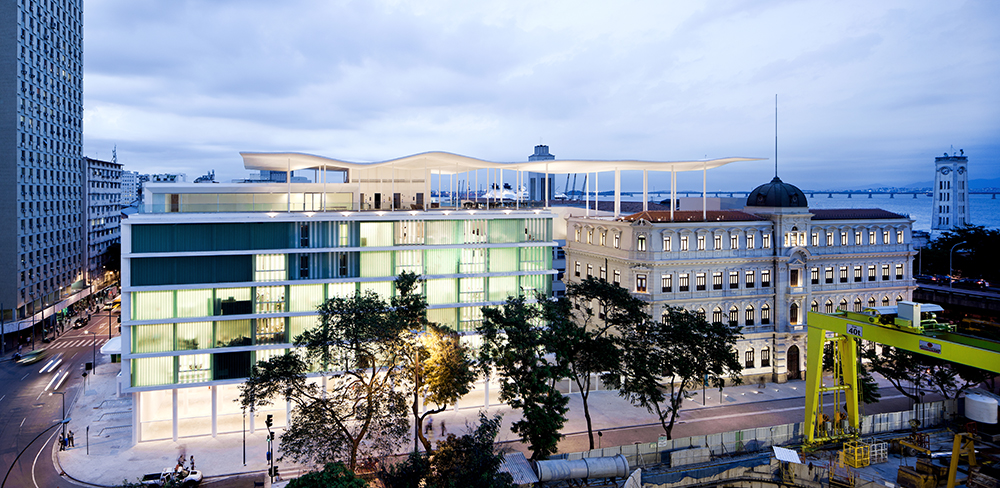
The Museu de Arte do Rio opened earlier this year. The project, designed by Bernardes + Jacobsen Arquitetura, involved three existing buildings: the Palacete Dom Joao; a former police building, which was re-clad and repurposed; and the old central bus station. A large, undulating canopy connects the structures.
Courtesy Andres Otero
ADELIA BORGES: A RIO RENAISSANCE
The design for the Museu de Arte in Rio by Bernardes + Jacobsen had the challenge of uniting three existing buildings, each with completely different architectural styles. The buildings are connected by a sleek, suspended roof that appears to float above the volumes. The project has brought new life to the port area of the city. Locals are immensely proud of the building. The poetic linking of the three structures enchants all who see it.
Borges is a Rio de Janeiro–based writer and critic.
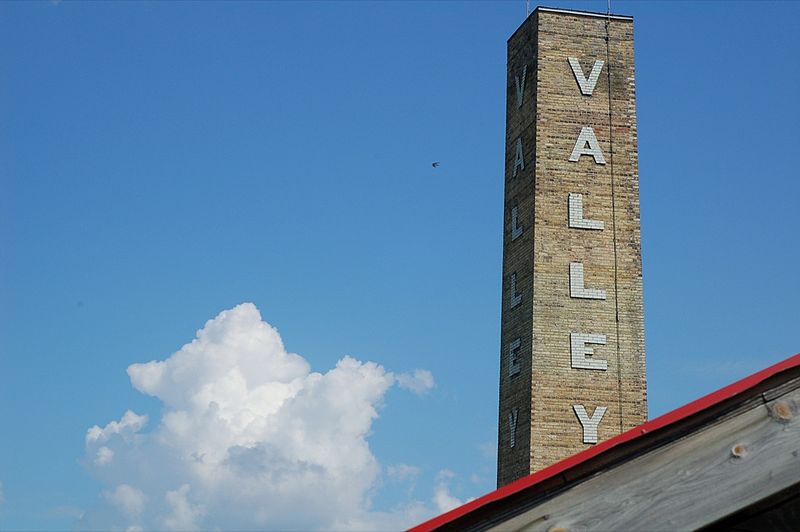
The smokestack at the Don Valley Brickworks.
Courtesy Derrick Mealiffe
RICHARD FLORIDA: OLD REFUGE FOR A NEW COMMUNITY
With 189 high rises under construction, Toronto looks a bit like Shenzhen or one of China’s other “instant cities.” It has more cranes in the air than just about anywhere else in North America (New York has just 82). But my favorite project in Toronto isn’t new and shiny—it’s the Evergreen Brick Works, a relic from the smokestack era that’s been reclaimed and repurposed as both an urban refuge and a model for sustainability and green living. With its wonderful gardens, ponds and historic buildings, the area around the old Don Valley Brick Works has become a second back yard for many Torontonians, a place to learn, play, create, hike, bike, dine, market, and, as of last month, to work, in the just-finished office, meeting, and event space in the old factory. Whenever my wife Rana and I have out of town visitors, we take them to the Brickworks to see how new and old, urban and rural, can become the locus of a new kind of community, embracing and inviting everyone from new immigrant families to creative entrepreneurs. For us—and for so many other Torontonians—it is the best kind of urbanism.
Florida is a professor and head of the Martin Prosperity Institute at the Rotman School of Management at the University of Toronto.
Layers of History
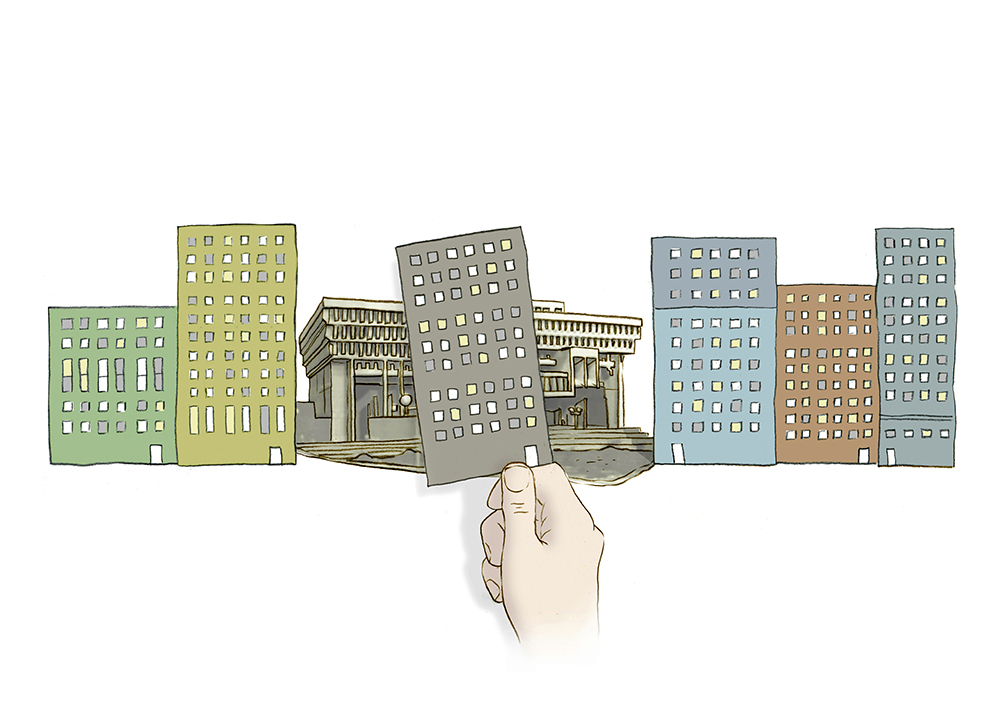
Illustration by Lief Parsons
ANTHONY FLINT: RAZING THE PAST
Over the last year we’ve seen how modernism can’t catch a break. A Frank Lloyd Wright home almost got demolished. A Wright showroom in Manhattan was gutted. A report came out of New York claiming it’s worse for the environment to let midcentury office buildings continue to operate because they are such energy hogs—that it would be “greener” to tear them down and start over. One of the candidates for mayor in Boston ran on a platform of demolishing the Le Corbusier–inspired City Hall. I wonder: Is this layer of modernism destined to be erased from architectural history? Will it be a combination of popular culture backlash and dubious environmental claims? What does the historic preservation community think? Remember, they wanted to tear down the Eiffel Tower after the Paris exhibition, too.
Flint is a fellow at the Lincoln Institute of Land Policy.
JOHN KING: STRIPPED TO THE BONE
There’s an interesting phenomenon going on in San Francisco. Developers are stripping 1960s-era buildings of their facades and reusing the structural bones. It’s a total inversion of the old manner of renovation, when nineteenth-century buildings were reused for the tactile delight of their details. Now the bones are all that is desired. It’s a testimony to the value of buildings. The basic workaday buildings nobody thought anything about are the buildings we now treasure. And what we’re starting to see with the buildings of the modern era is this total disinterest in their character, but an appreciation of the space and forms they created.
King is the urban design critic for the San Francisco Chronicle.
ALEXANDROS WASHBURN: AFTER THE STORM
Even though it happened last year, a superstorm named Sandy was this year’s big idea that changed everything. Sandy was the kind of idea that starts as an abstraction and becomes a fact. Inarguable. Unstoppable. It left us physically, emotionally, economically, even morally changed. These are the most dangerous ideas, the ones that change the way you look at things. We can’t see our city in the same way as before. We can’t build in the same way. Our idea of living in the city is now one of adapting to climate change.
Washburn is the author of The Nature of Urban Design: A New York Perspective on Resilience.

New York’s Pennsylvania Station building, which was razed to make space for Madison Square Garden. This photograph was taken in 1962.
Courtesy the Library of Congress
MICHAEL KIMMELMAN: LANDMARK DECISION
The New York City Council’s decision to deny Madison Square Garden’s request to stay put, in perpetuity, and instead grant the Garden only a 10-year permit, is a potential watershed. It’s meant to compel negotiations about moving the arena and redesigning Pennsylvania Station underneath it, undoing one of the most calamitous urban decisions of the past century—the demolition of the old Penn Station. The move is in keeping with an increasing global focus on transit hubs as an economic and social engine. The welfare of millions of commuters who use Penn Station is at stake. The council’s decision may ultimately produce nothing—it will depend on whether somebody with real authority can force the parties to negotiate. But it may also be seen as a critical turning point in 21st century urbanism and public-spirited politics.
Kimmelman is the architecture critic and senior critic at the New York Times.
International Currents

Illustration by Lief Parsons
INGA SAFFRON: THE HIPSTER INVASION
The repopulation of big cities after a long period of decline is a major trend. What’s driving it, along with some baby boomers returning to cities, is a greater openness on the part of millennials to living in urban places. There are some interesting historic, demographic, and cultural reasons why this group is so important to the future of cities. This is the first generation that grew up with the Internet, so they’re much more mobile and have more choice about place. They have no memory of the upheavals of cities, and therefore have fewer negative views of them. They will have a profound effect on how cities populate in the future.
Saffron is the architecture critic at the Philadelphia Inquirer.
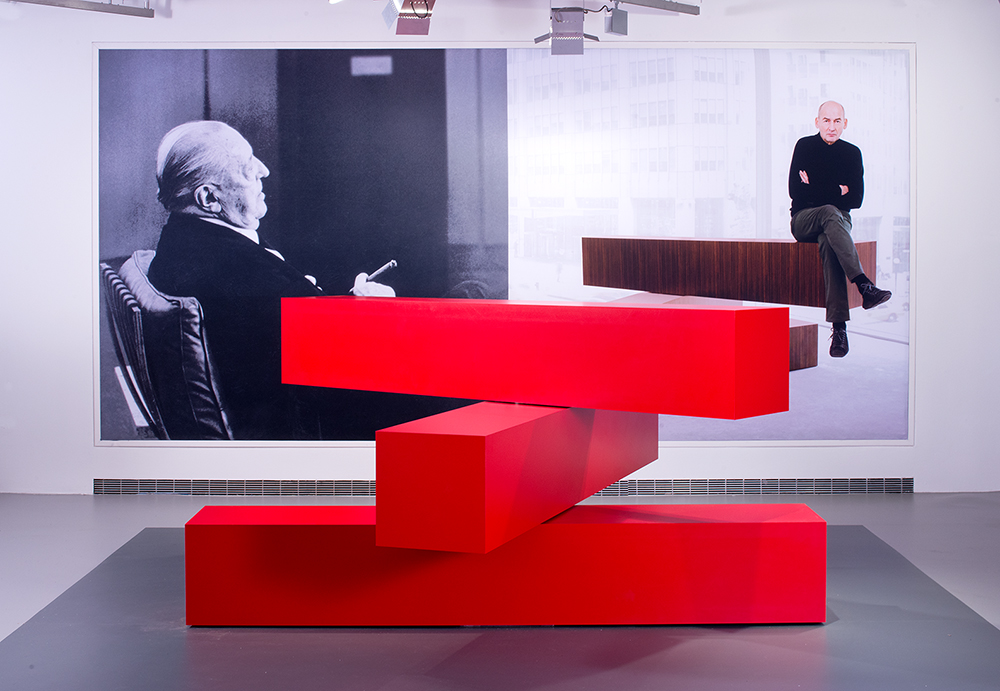
Knoll and OMA debuted their Tools for Life line at the 2013 Milan Furniture Fair.
Courtesy Knoll
HANS IBELINGS: OMA’S PRACTICAL JOKE?
To be honest, I cannot come up with any building or design that is more than nice, good, or possibly even great architecture. There are marvelous projects by the stars. I can see the value of all the sustainable, socially concerned do-gooders of urban agriculture, DIY, and other bottom-up projects. I appreciate every architect who’s dealing with transforming the existing stock. But none of them made my heart beat faster. The Tools for Life furniture by OMA is the only project that I do not know what to think of. Is it crazy? Is it a parody? Or a revolutionary approach towards furniture? These pieces aren’t immediately appealing, which might be another reason to believe they’re something totally new.
Ibelings is the editor and publisher of the Architecture Observer.
NADINE BOTHA: CAPE TOWN’S BIG MOMENT
Cape Town is the first African city to be named a World Design Capital. Already, we’re feeling the impact of a mayor taking on design on a systemic level. Whether that effort is lip service or whether it will have a lasting impact remains to be seen. The mayor has pledged a community improvement design project in every ward of the city, and the ruling political party has released a “design strategy” for the province. It’s going to be interesting to live in a city with design as its primary agenda for a year.
Botha is a Cape Town–based writer and critic.





